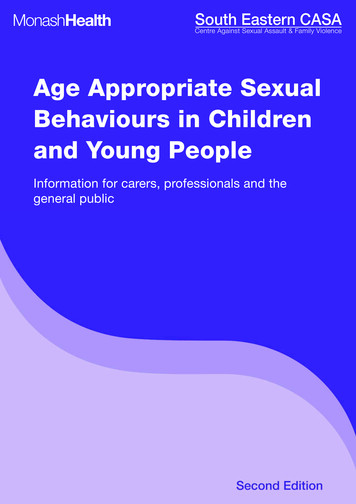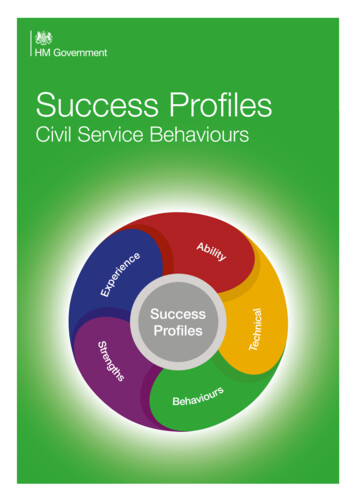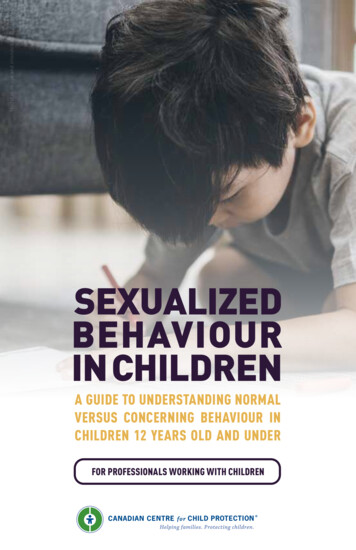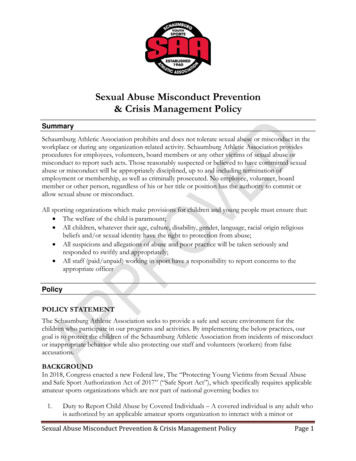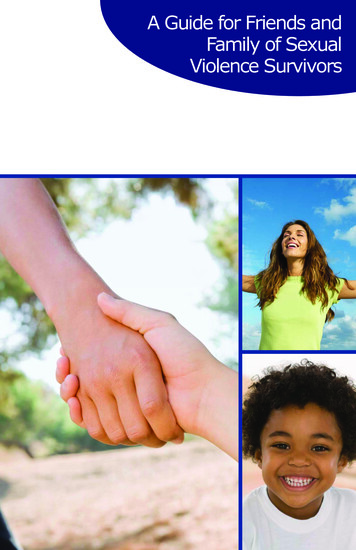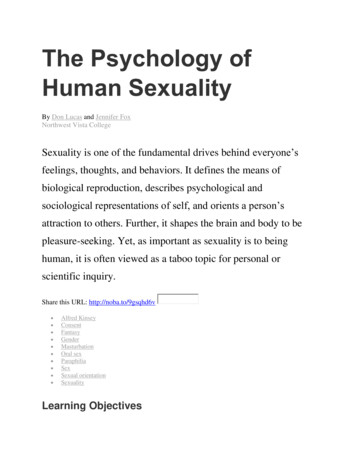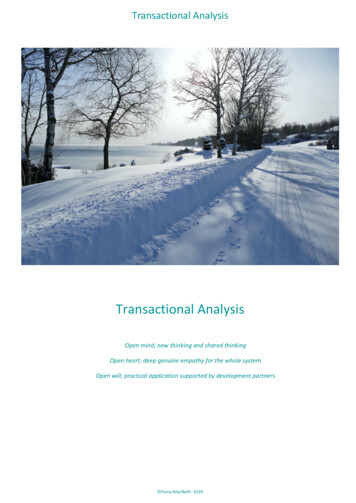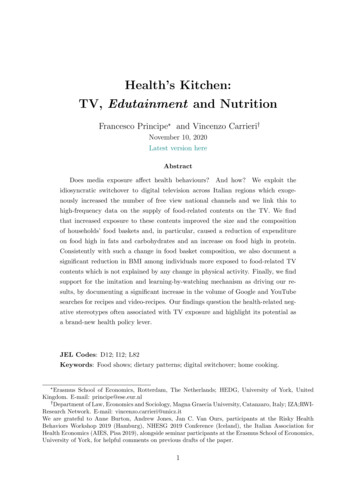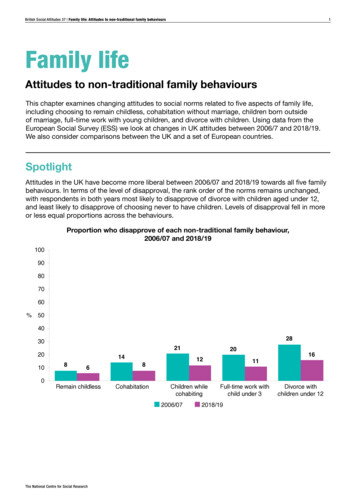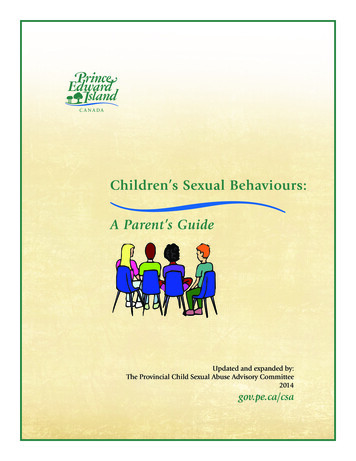
Transcription
Children’s Sexual Behaviours:A Parent’s GuideUpdated and expanded by:The Provincial Child Sexual Abuse Advisory Committee2014gov.pe.ca/csa
Table of ContentsIntroduction . . . . . . . . . . . . . . . . . . . . . . . . . . . . . . . . . . . . . . . . . . . . . . . . . . . . . . 1Normal and Expected Sexual Behaviours . . . . . . . . . . . . . . . . . . . . . . . . . . . . . . 1A Guide to Sexual Behaviour of Children . . . . . . . . . . . . . . . . . . . . . . . . . . . . . . . 2Responding to Children’s Sexual Behaviour . . . . . . . . . . . . . . . . . . . . . . . . . . . . 6Provincial Contacts for Help and Advice . . . . . . . . . . . . . . . . . . . . . . . . . . . . . . . 7References . . . . . . . . . . . . . . . . . . . . . . . . . . . . . . . . . . . . . . . . . . . . . . . . . . . . . . 8Children’s Sexual Behaviors: A Parent’s Guide
PurposeThis guide is intended to help parents and caregivers:1. gain knowledge of children’s sexual behaviours;2. respond appropriately to a range of developmentally appropriate and inappropriatesexual behaviours;3. determine if the child’s behaviour appears to be normal curiosity or an indicationthat professional help should be sought.
IntroductionIt is normal for children under the age of 12 to behave in sexual ways. In fact, according to WilliamFriedrich of the Mayo clinic, sexual behaviour in children peaks between the ages of three and six.1However, some sexual behaviour in children may be an indication that there is something wrong –that the child has been sexually molested, has been exposed prematurely to adult sexual knowledge,or has begun to use sexual behaviour as a way to get emotional needs met, etc.It is important to keep in mind that there are no absolutes. Normal, healthy behaviour covers a widerange and may not be expressed the same, or to the same extent, in every child. Similarly, problembehaviour covers a range from less to more severe, and may not mean the same thing in every child.Normal and Expected Sexual BehavioursMost children will engage in at least some sexual behaviour before the age of 12. For very youngchildren (four or younger) such behaviours are more likely to be engaged in openly and come to theattention of adults.2Around age six, children develop more of a sense of privacy, such that adults are less likely to beaware of their sexual behaviour. According to William Friedrich, it is likely that sexual interest andbehaviour in children continue, but as children learn cultural standards these interests are concealed.1A greater level of sexual interest may occur with the beginning of puberty, which ranges from age10 to 15 for boys, and age eight to 14 for girls. The age at which puberty begins varies from child tochild and is something that has changed over the past 40 to 50 years, with puberty starting six to 24months earlier than it did for our grandparents and great-grandparents. 3,4Normal sexual behaviour in children is part of how they learn about and explore the world. In thissense, it is no different from the other things that show up in their play. According to Toni CavanaghJohnson, Ph.D., an expert in the field of children’s sexual development, natural and healthy sexualexploration during childhood is: “an information gathering process wherein children explore eachother’s bodies by looking and touching (e.g. playing doctor), as well as explore gender roles andbehaviours (e.g. playing house).”51Children’s Sexual Behaviors: A Parent’s Guide
A Guide to Sexual Behaviour of ChildrenThe information in the charts below is a way to understand children’s behaviours related to sex andsexuality by age group.5 It is reprinted with written permission from the author, psychologist ToniCavanagh Johnson, Ph.D.The following charts identify sexual behaviours of children that are natural and healthy, sexualbehaviours that are of concern, and sexual behaviours that require immediate consultation.Dr. Cavanagh Johnson cautions that this guide cannot be used to determine whether or not a childhas been sexually abused, and that when assessing the seriousness of a particular behaviourfound within these charts, it is important to consider where the behaviour has taken place, howthe behaviour was discovered, and the relationship between the children who were involved in thebehaviour.A range of sexual behaviours by age is described in each column of the following the following charts: Natural and Healthy – These behaviours are within the expected normal range for children of thisage and developmental level. Children may engage in a few, several, or none of the behaviours. Of Concern – These behaviours are seen in children who are overly concerned about sex andsexuality for their age and developmental level. Consultation with a professional is recommendedif a child demonstrates several of these behaviours, or if the behaviour persists in spite ofinterventions. Seek Professional Help – These behaviours require immediate consultation with a professionalbecause they are indicative of a child who is experiencing confusion in the area of sexuality.2Children’s Sexual Behaviors: A Parent’s Guide
Natural and HealthyPreschoolChildren(up to age five)Of ConcernSeek Professional HelpTouches/rubs own genitalswhen diapers are beingchanged, when going tosleep, when tense, excitedor afraid or because it feelsgood.Continues to touch/rub genitalsin public after being told “no”consistently.Touches/rubs self to the exclusionof normal childhood activities.Hurts own genitals by touching/rubbing.Explores differencesbetween males andfemales, boys and girls.Asks continuous questionsPlays male or female roles in anabout genital differences after all angry, sad or aggressive manner.questions have been answered. Hates own/other sex.Touches the “private parts”of familiar adults andchildren with hand or body.Touches/rubs the “private parts” Sneakily touches/rubs the “privateof familiar children or adults after parts” of adults or children and, ifthey have been told consistently questioned, deny it.not to do so.Takes advantage ofopportunity to look at nudepeople.Stares at nude people even after Asks people to take off theirhaving seen many people nude. clothes. Tries to forcibly undresspeople.Asks about the genitals,breasts, intercourse,babies.Keeps asking people evenafter parent has answered allquestions at an age appropriatelevel.Asks unfamiliar people afterparent has answered allquestions. Sexual knowledge toogreat for age.Erections.Very frequent erections.Fearful of erections.Likes to be nude. May show Wants to be nude in publicothers his/her genitals.after the parent repeatedly andconsistently says “no.”Refuses to put on clothes.Secretly shows “private parts” inpublic after many scoldings.Interested in watchingpeople doing bathroomfunctions.Refuses to leave people alonein bathroom. Forces way intobathroom.Interest in watching bathroomfunctions does not wane afterdays/weeks.Interested in having/birthing Boys’ interest does not wanea baby.after several days/weeks of playabout babies.Displays fear or anger aboutbabies, birthing or intercourse.Child stands/sits too closeto familiar adults andchildren.Child stands/sits too close tounfamiliar adults and children.After consistent reminders by theadults, the child stands/sits withhis/her body touching familiar/unfamiliar adults, which makesthe adults uncomfortable.Uses dirty words forbathroom and sexualfunctions.Continues to use “dirty” words athome after parent consistentlysays “no,” and parents do notswear.Uses “dirty” words in public and athome after many strong scoldingsand parents do not swear.Interested in own feces.Smears feces on walls or floormore than one time.Repeatedly plays or smears fecesafter scolding. Angry when doingit.Plays “doctor” inspectingothers’ bodies, including“private parts.”Frequently plays “doctor” andgets caught, after being told “no”consistently.Forces child to take off clothesand play “doctor.”Puts something in owngenitals or rectum one timefor curiosity or exploration.Puts/tries to put something inAny coercion, force, pain ingenitals or rectum of self or other putting/trying to put something inafter being told “no.”genitals or rectum of self or otherperson.Plays house, acts out rolesof mommy and daddy.Humping other children withSimulated or real intercourseclothes on after being told not to. without clothes; oral genitalcontact.Copyright Toni Cavanagh Johnson, Ph.D. All Rights Reserved. www.tcavjohn.com
Normal RangeKindergartenThrough FourthGradeChildrenOf ConcernSeek Professional HelpAsks about the genitals, breast, Shows fear or anxiety aboutintercourse, babies.sexual topics.Asks endless questions aboutsex after curiosity satisfied.Sexual knowledge/vocabulary/thoughts too advanced for age.Interested in watching/peekingat people doing bathroomfunctions.Refuses to leave people alonein bathroom.Keeps getting caughtwatching/peeking at othersdoing bathroom functions.Uses “dirty” words for bathroom Uses “dirty” words with adultsfunctions, genitals, and sexual after parents consistentlybehaviour.says “no” and punishes thechild.Continues use of “dirty”language even after exclusionfrom school and favoriteactivities and parents/relativesdo not use these words.Plays “doctor.” The childinspects another child’s body,including “private parts.”Frequently plays “doctor” andgets caught after being toldnot to do so.Forces child to take clothes offand touches/inserts somethingin child’s “privates.”Boys and girls are interested inhaving/birthing a baby.Boy keeps making believehe is having a baby aftermonth/s.Child displays fear or angerabout babies or intercourse.Touches/rubs own genitalswhen going to sleep, whentense, excited, afraid orbecause it feels good. Showsothers his/her genitals in aprivate location.Shows genitals in public.Continues to touch/rubgenitals in public after beingtold “no” consistently. Rubsgenitals on furniture or otherobjects after the parent says“no” and punishes child.Shows genitals at school and/orother places to express angeror disdain for authority.Plays house, may simulate allroles of mommy and daddy.Repeatedly humping otherchildren with clothes on.Repeatedly imitates sexualbehaviour with dolls/stuffedtoy.Humping others while naked.Intercourse with another child.Forcing sexual contact on achild or adult.Thinks other gender childrenare “gross” or have “cooties.”Chases them.Continues to use “dirty”language after other childrenreally complain.Uses bad language againstother child’s family. Makessexual threats.Talks about sex with friends.Talks about having a girl/boyfriend.Sex talk gets child introuble. Romanticizes allrelationships. Sexualizes allrelationships.Talks about sex and sexual actshabitually. Repeatedly in troublewith regard to sexual talk.Wants privacy when inbathroom or changing clothes.Becomes very upset whenobserved changing clothes,using toilet or bathing.Aggressive or fearful in demandfor privacy.Likes to hear and tell “dirty”jokes, makes a few sexualsounds.Keeps getting caught telling“dirty” jokes or making sexualsounds, e.g., sighs, moans.Still gets caught telling “dirty”jokes, or making sexual sounds,even after exclusion fromschool and fun activities.Plays games with same-agedchildren related to sex andsexuality.Wants to play games relatedto sex and sexuality withmuch younger, older orunknown children.Child/children force others toplay sexual games that makethem uncomfortable.Copyright Toni Cavanagh Johnson, Ph.D. All Rights Reserved. www.tcavjohn.comContinued on next page.
Normal RangeKindergartenThrough FourthGradeChildrenOf ConcernSeek Professional HelpDraws genitals on humanfigures for artistic expressionor because figure is beingportrayed in the nude.Draws genitals on some nudefigures but not others or ondrawings of clothed people.Genitals disproportionate tosize of body.Genitals stand out as mostprominent feature of drawing.Drawings of intercourse, groupsex, sex with animals, sadism,masochism, etc.Explores differences betweenadult males and females, boysand girls.Confused about male/femaledifferences after all questionshave been answered.Plays male or female roles ina sad, angry or aggressivemanner exclusively.Takes advantage of opportunity Stares/sneaks to stare atAsks others to take off theirto look at nude people.nude people after punishment clothes. Tries to forciblyand having seen manyundress children or adults.people nude.Pretends to be oppositegender.Talks very negatively aboutown gender.Hates/fears being own gender.Hates own genitals.Wants to compare genitals with Wants to compare genitalspeer-aged friends.with much older or muchyounger people.Demands to see the genitals,breasts, or buttocks of others.Looks at the genitals, buttocks,or breasts of others.Stares at the genitals,breasts, or buttocks of othersmaking them uncomfortable.Continuously sneaks and peeksat genitals, breast, or buttocksof others after being caughtmany times.Interest in touching genitals,breast, or buttocks of othersame-age child or have childtouch his/hers.Makes others uncomfortableby requests to touch theirgenitals, breasts, or buttocksor have them touch his/hergenitals, breast, or buttocks.Coerces unwilling child to touchhis or her genitals, breasts, orbuttocks or allow touching oftheirs. Forced or mutual oral,anal, or vaginal sex.Kisses/hugs familiar adults andchildren. Allows kisses/hugs byfamiliar adults and children.French kissing. Talks/actsin a sexualized manner withunknown children. Fearful ofhugs and hisses by adults.Gets very anxious when seesdisplays of affection. Kisses/hugs unfamiliar adult or child.Talks/acts in a highly sexualizedmanner with known or unknownadults/ children, which makesthem feel uncomfortable.Physical contact with any adultcauses agitation, anger, fear oranxiety to the child or adult.Looks at nude pictures on theInternet, videos, magazines,etc.Continuous fascination withnude pictures that gets childin trouble.Wants to masturbate to nudepictures or display them.Erections.Continuous erections or fearof erections.Painful erections or hurting selfto stop erection.Puts something in owngenitals/rectum for thephysical sensation, curiosity orexploration.Puts something in owngenitals/rectum frequently orwhen it feels uncomfortable.Puts something in thegenitals/rectum of other child.Any coercion or force in putting/trying to put something ingenitals/rectum of other child.Causes harm to own/othersgenitals/rectum.Interest in breeding behaviourof animals.Touching genitals of animals.Sexual behaviours withanimals.Copyright Toni Cavanagh Johnson, Ph.D. All Rights Reserved. www.tcavjohn.com5Children’s Sexual Behaviors: A Parent’s Guide
Responding to Children’s Sexual BehaviourParents and caregivers may feel uncomfortable if they discover their child engaging in sexualbehaviour but it is important not to overreact, shame, embarrass, or discipline the child. A parent orcaregiver’s reaction to a child’s sexual behaviour is important for the child’s well-being.The Child Sexual Abuse Committee of the National Child Traumatic Stress Network and TheChildren’s Assessment Center recommend that when responding to sexualized behaviour orsexualized play between children:2,6 Try to figure out what happened. To do this, it is important to stay calm. Staying calm will allowyou to make clear decisions about what you say and/or do, rather than acting on strong emotions. Do not overreact. By staying calm and handling the situation without overreacting, children willdevelop a positive sense of self and sexuality. Remain composed. Try taking a long, deep breath, counting to ten, or even stepping away fromthe situation for a few minutes before saying anything. After taking a few moments to collect yourthoughts, and to consult with a spouse or partner if feeling unsettled, you may then wish to speakto your child. Ask questions. When talking to children about sexual behaviours, it is important to maintain acalm and even tone of voice and to ask open-ended questions as much as possible. This allowsfor a child to tell what happened in their own words, rather than just answering yes or no. A parentmight ask the child: what were you doing?, how did you get the idea?, how did you learn aboutthis?, how did you feel about doing it?. Stop the behaviour. If children are masturbating in public or in front of others, explain to themthat it is not appropriate to touch their private parts in public and that if they feel they need to touchtheir private parts they need to do it in private, hence “private parts.” Children should not be toldthat it is “bad,” “dirty,” or “nasty” when found masturbating and they should not be punished. Whenchildren are exploring their sexuality with other children, parents should explain to them that whenthey are playing with their friends they need to leave their clothes on and that it is not okay totouch or show private parts. Parents should also ask the children if they have any questions andbe available to answer any that they ask. Don’t punish. Don’t yell at or punish them. Punishing such behaviours can lead to sexualinhibitions later on and hinder a child’s sexual development. Tell children that their behaviour isnot appropriate by being clear and direct without making them feel guilty. Redirect the behaviour. Redirect the child’s behaviour into a more acceptable play activity.Introduce a new game or other activities to distract their behaviour.Children’s Sexual Behaviors: A Parent’s Guide6
Educate the child. If you encounter a situation where the child is embarrassed but otherwisenot distressed, use it as an opportunity for teaching the child about healthy boundaries and rulesabout sexual behaviour. Do not ignore. Just because a behaviour is typical doesn’t mean the behaviour should beignored. When children participate in sexual behaviour it often indicates that they need to learnsomething. Teach what the child needs to know. For example, a parent may teach a child that it’sokay to be curious about other people’s bodies but that private parts should be kept private, evenwith friends.If you experience a concerning situation, do not be embarrassed or afraid to seek professional help.If you have any questions about sexuality in children, or if you are concerned that a child’s sexualbehaviour has gone beyond what is considered natural and healthy, you can get help and advice bycalling the following numbers:Provincial Contacts for Help and AdviceProvincial Resource for ConsultationLindy AffleckSexual Deviance Assessment and Treatment ClinicianCommunity and Correctional ServicesDept. of Environment, Labour, and JusticeTelephone (902) 368-6391Community Mental Health Children’s Centralized Intake1-866-833-5443 (toll free)368-4427 (Charlottetown)Provincial Child Protection ServicesDuring regular business hours368-66571-877-341-3101 (toll free)After hours, holidays and weekends368-68681-800-341-6868 (toll free)To report an incident of child sexual abuse, contact Child Protection Services atthe numbers above or call 911Note: The original version of this guide was developed in 2001 by Randall Fletcher, Prince Edward Island SexualDeviance Specialist, and reprinted in 2005. This 2013 edition of the guide is an updated and expanded version of theoriginal resource for parents and others wanting information on children’s sexual development.Children’s Sexual Behaviors: A Parent’s Guide
ReferencesFriedrich, W. N., Grambsach, P., Broughton, D., Kruiper, J., and Beilke, R. (1991). Normative sexualbehaviour in children. Pediatrics, 88 (3), 456-464.1The National Child Traumatic Stress Network (NCTSN). (2009). Sexual development and behaviourin children: Information for parents and caregivers. U.S. Department of Health and Humans Services:Substance Abuse and Mental Health Services Administration (SAMHSA). Retrieved November 26,2012 from s-20092Herman-Giddens, M. E., et al. (2012). Secondary Sexual Characteristics in Boys: Data From thePediatric Research in Office Settings Network. Pediatrics, e1058-e1068. Doi:10.1542/peds.2011-3291.3Herman-Giddens, M.E., et al. (1997). Secondary sexual characteristics and menses in young girlsseen in office practice: a study from the Pediatric Research in Office Settings network. Pediatrics, (4),505-512.4Johnson, T. C. (2013). Understanding children’s sexual behaviours: What’s natural and healthy.www.tcavjohn.com5The Children’s Assessment Center. (undated). Children’s sexual behaviour and body safety:A guide for parents. Grand Rapids, MI. Retrieved November 26, 2012 from hildren’s Sexual Behaviors: A Parent’s Guide
with regard to sexual talk . Wants privacy when in bathroom or changing clothes . Becomes very upset when observed changing clothes, using toilet or bathing . Aggressive or fearful in demand for privacy . Likes to hear and tell “dirty” jokes, makes a few sexual sounds . Keeps getting caugh
